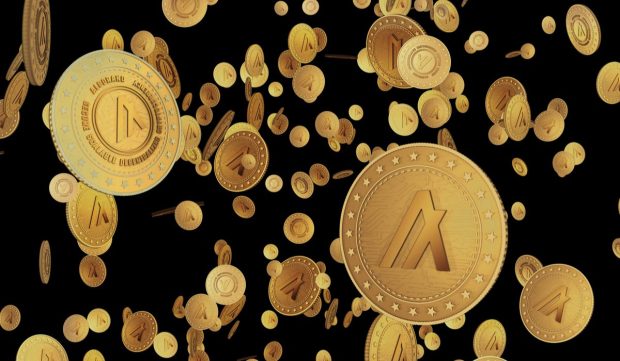PYMNTS Blockchain Series: What’s Algorand? The Blockchain Securing Transactions by Spreading the Wealth

Over the course of this series of articles, we are going to look at the top blockchains in cryptocurrency, with a goal of helping you understand what they are, how they work, what they do, and what their pros and cons are.
You’ll come out of this series not only with a better sense of what cryptocurrency is all about; you’ll understand why the way a token works — the way its blockchain processes transactions — is key to its success or failure as a digital asset.
See also: PYMNTS Blockchain Series
What Is Ethereum? The Blockchain That Moved Crypto Beyond Currency
What Is Bitcoin Cash? The No. 2 Payments-Focused Crypto Goes Its Own Way
What Is BNB Chain and Why Isn’t It Binance Anymore?
What is Polygon? An Ethereum Killer Hedges Its Bets
What Is Stellar’s Lumen? A Payments Crypto That Isn’t Trying to Overthrow the Financial System
What Is XRP? The Cryptocurrency Making A Ripple In Payments
So, what is Algorand?
First and foremost, it’s an Ethereum-killer, a smart-contract platform that aims to provide a faster, cheaper, more secure, more scalable blockchain transaction.
But Algorand has a number of unique features that make it worth a look, particularly for payments on traditional and decentralized finance (DeFi) projects. Before that, however, it also has a creator who’s worth a look. Algorand is the brainchild of Silvio Micali, an Italian MIT professor and Turing Award-winning mathematician specializing in cryptography, secrecy and blockchain.
By the numbers, Algorand can process 1,000 transactions per second (TPS) and has a sub-5-second block time, which refers to the frequency with which new blocks of transactions are written onto the blockchain, and thus finalized. At the time of this writing, its transaction fee is $0.0012.
It’s also a two-layer blockchain, in which the base Layer 1 handles simple transactions while the more resource-intense smart contracts and complex transactions happen off-chain, on Layer 2, keeping the blockchain from getting clogged, one of the main problems (along with transaction fee size) that has plagued Ethereum.
Projects can create their own tokens as Algorand Standard Assets, or ASAs, which can be used to create standard cryptocurrency tokens, stablecoins, central bank digital currencies, and nonfungible tokens (NFTs) among others.
Algorand is also one of the more ambitious attempts to solve the “blockchain trilemma” — which refers to the balancing act necessary to keep a blockchain secure, scalable and decentralized. The “lemma” part the phrase shares with “dilemma” is that it’s generally necessary to weaken at least one to strengthen the other two.
See also: In $625M Hack, a Bigger Crypto Security Problem Is on Display
Purity
Like most smart-contract platforms, Algorand runs on an environmentally friendly proof-of-stake, or PoS, consensus mechanism to secure its blockchain and validate new transactions as they are added to new blocks. However, it uses a variant called pure proof-of-stake, or PPoS, that spreads the consensus process — and subsequent block rewards of new ALGO tokens — among a far larger group than most PoS platforms.
Read more: PYMNTS Crypto Basics Series: What’s a Consensus Mechanism and Why Is It Destroying the Planet?
It differs from other PoS consensus mechanisms in that most rely on a limited number of validators, who put up stakes that amount to bonds for good behavior.
While the PoS validators are chosen randomly for any one transaction, they are chosen based on their share of the funds staked — so if you have 5% of the pool, you’ll be selected 5% of the time. So to increase their earnings, they allow other token holders to stake tokens with them, sharing the block reward of new tokens. Which gives an extra layer of security, as validators are incentivized to be honest because getting their stake “slashed” will cause the token holders sharing their tokens to part company.
Under Algorand’s PPoS system, anyone with one ALGO can set up as a staker — Ethereum requires 32 ETH, worth more than $100,000 — by creating a participation node and locking in tokens. Normally the low stake at risk would decrease security. But the PPoS mechanism randomly selects one stakeholder as block leader to build the block but then randomly selects another large group that votes to add the block to the blockchain. However, everyone who holds at least 1 ALGO shares in the block reward, creating a very large pool involved in validation.
“Recruiting network participants from the entire user pool is the most random and also the most decentralized, which makes PPoS potentially more secure,” the Algorand website says.
No Forks
Another big difference is that Algorand’s blockchain cannot be hard forked — something it says should of particular interest to NFT holders.
When a blockchain is forked it essentially breaks in two, with the smaller chain becoming a separate chain from that point forward. But the tokens are duplicated up until the point of the fork. So, for example, when Bitcoin Cash forked off of Bitcoin to create a more scalable, payments-focused blockchain, token holders got the new token, BCH, in proportion to their BTC holdings. Which is fine and dandy for standard cryptocurrencies.
For NFTs however, that’s a big problem, as they are unique.
If there is no agreement on which remains the official chain, Algorand says, “then NFTs holders get a duplicate version of the NFT, and that is an issue since NFTs should be unique. … If there is a mirror chain where an NFT asset has become duplicated, there is nothing digitally unique about it.”
